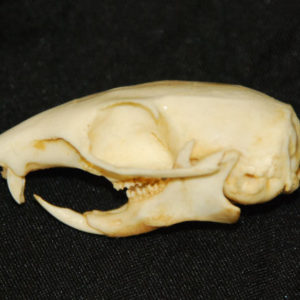Tamias striatus Skull Replica measures 1.7 inches. Tamias striatus Skull Replica is museum quality polyurethane cast. 2-part skull (separate cranium and jaw). Made in USA. Known as Eastern chipmunk. Our precise skull can be used as a teaching tool, museum skull exhibit, home decor skull, or office decor skull.
Tamias striatus lives in deciduous wooded areas and urban parks throughout the eastern United States and southern Canada. It prefers locations with rocky areas, brush or log piles, and shrubs to provide cover.
Tamias striatus can climb trees well, but constructs underground nests with extensive tunnel systems, often with several entrances.
To hide the construction of its burrow, they carry soil to a different location in its cheek pouches. It also lines the burrow with leaves, rocks, sticks, and other material, making it even harder to see.
Eastern chipmunk or Tamias striatus has several bird-like or chattering calls; one is a trill at the rate of 130 vibrations per minute and another is a lower-pitched, clicking sound.
Tamias striatus is mainly active during the day, spending most of its day foraging. It prefers bulbs, seeds, fruits, nuts, green plants, mushrooms, insects, worms, and bird eggs. Like other chipmunks, it transports food in pouches in its cheeks.
A small species, Eastern chipmunk or Tamias striatus reaches about 12 in. in length including the tail, and a weight of 2.3 to 5.3 oz.
It has reddish-brown fur on its upper body and five dark brown stripes contrasting with light brown stripes along its back, ending in a dark tail. It has lighter fur on the lower part of its body.
Tamias striatus has a tawny stripe that runs from its whiskers to below its ears, and light stripes over its eyes.
It has two fewer teeth than other chipmunks and four toes each on the front legs, but five on the hind legs.
The Eastern Chipmunk lives in deciduous wooded areas and urban parks throughout the eastern United States and southern Canada. It prefers locations with rocky areas, brush or log piles, and shrubs to provide cover.
The Tamias striatus can climb trees well, but constructs underground nests with extensive tunnel systems, often with several entrances. Chipmunks line their burrows with leaves, rocks, sticks, and other material.


